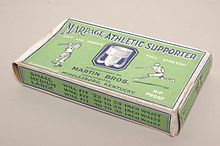
Corrugated fiberboard, corrugated cardboard, or corrugated is a type of packaging material consisting of a fluted corrugated sheet and one or two flat linerboards. It is made on "flute lamination machines" or "corrugators" and is used for making corrugated boxes. The corrugated medium sheet and the linerboard(s) are made of kraft containerboard, a paperboard material usually over 0.25 millimetres (0.01 in) thick.

A box is a container with rigid sides used for the storage or transportation of its contents. Most boxes have flat, parallel, rectangular sides. Boxes can be very small or very large and can be used for a variety of purposes, from functional to decorative.

Paperboard is a thick paper-based material. While there is no rigid differentiation between paper and paperboard, paperboard is generally thicker than paper and has certain superior attributes such as foldability and rigidity. According to ISO standards, paperboard is a paper with a grammage above 250 g/m2, but there are exceptions. Paperboard can be single- or multi-ply.

A carton is a box or container usually made of liquid packaging board, paperboard and sometimes of corrugated fiberboard. Many types of cartons are used in packaging. Sometimes a carton is also called a box.

A squround is a container whose shape is between a square and a round tub. It resembles an oval but is sometimes closer to a rectangle with rounded corners. These allow the contents to be easily scooped out of the container. The name is a portmanteau for "square round" (cartons), referring to a compromise between a square and a round carton.

Cardboard boxes are industrially prefabricated boxes, primarily used for packaging goods and materials. Specialists in industry seldom use the term cardboard because it does not denote a specific material. The term cardboard may refer to a variety of heavy paper-like materials, including card stock, corrugated fiberboard, and paperboard. Cardboard boxes can be readily recycled.
Coated paper is paper that has been coated by a mixture of materials or a polymer to impart certain qualities to the paper, including weight, surface gloss, smoothness, or reduced ink absorbency. Various materials, including kaolinite, calcium carbonate, bentonite, and talc, can be used to coat paper for high-quality printing used in the packaging industry and in magazines.
Skin pack, or skin packaging, is a type of carded packaging where a product is placed on a piece of paperboard or in trays, and a thin sheet of transparent plastic is placed over the product and paperboard or trays. The printed paperboard/tray usually has a heat-seal coating. The plastic film is softened by heat and draped over the product on the card/tray. Vacuum is used to assist a firm fit. The film bonds to the heat-seal coating on the paperboard.
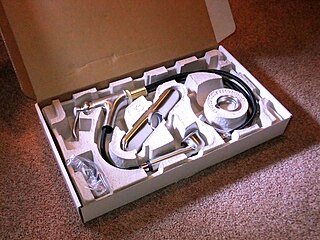
Molded pulp or molded fiber is a packaging material, that is typically made from recycled paperboard and/or newsprint. It is used for protective packaging or for food service trays and beverage carriers. Other typical uses are end caps, trays, plates, bowls and clamshell containers.

Packaging engineering, also package engineering, packaging technology and packaging science, is a broad topic ranging from design conceptualization to product placement. All steps along the manufacturing process, and more, must be taken into account in the design of the package for any given product. Package engineering is an interdisciplinary field integrating science, engineering, technology and management to protect and identify products for distribution, storage, sale, and use. It encompasses the process of design, evaluation, and production of packages. It is a system integral to the value chain that impacts product quality, user satisfaction, distribution efficiencies, and safety. Package engineering includes industry-specific aspects of industrial engineering, marketing, materials science, industrial design and logistics. Packaging engineers must interact with research and development, manufacturing, marketing, graphic design, regulatory, purchasing, planning and so on. The package must sell and protect the product, while maintaining an efficient, cost-effective process cycle.
A case of some merchandise is a collection of items packaged together. A case is not a strict unit of measure. For consumer foodstuff such as canned goods, soda, cereal, and such, a case is typically 24 items, however cases may consist of any quantity depending on manufacturer packaging - cases are typically found in multiples of 4 or 6. For larger bottles such as gallon jugs, a case is typically 4.

A bulk box, also known as a bulk bin, skid box, pallet box, bin box, gaylord, or octabin, is a pallet-size box used for storage and shipping of bulk or packaged goods. Bulk boxes can be designed to hold many different types of items such as plastic pellets, watermelons, electronic components, and even liquids; some bulk boxes are stackable.

A juice box, also called a carton (BrE) or popper (AuE), is a small container used to conveniently carry and consume drinks. They are frequently made of paperboard with an aluminum foil lining, but variations exist. Juice boxes are most popular with children, although other uses include emergency drinking water, milk, and wine.

A stand-up pouch or doypack is a type of flexible packaging that is able to stand erect on its bottom for display, storage, and convenience. It has characteristics of plastic bags, water bottles, and retort pouches. The bottom part of a stand-up pouch is gusseted to provide support for display or use.
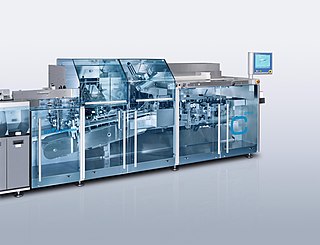
A cartoning machine or cartoner, is a packaging machine that forms cartons: erect, close, folded, side seamed and sealed cartons.
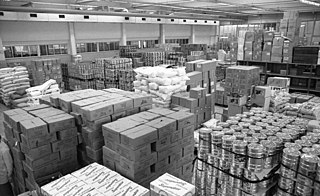
Food storage containers are widespread in use throughout the world and have probably been in use since the first human civilizations.

A multi-pack also known as multipack is packaging that combines or holds multiple items or smaller packages.
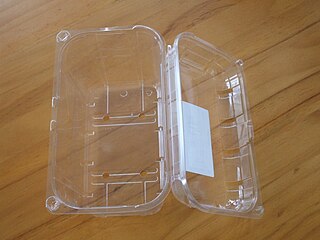
A clamshell is a one-piece container consisting of two halves joined by a hinge area which allows the structure to come together to close. Clamshells can be made to be reusable and reclosable or can be sealed securely.
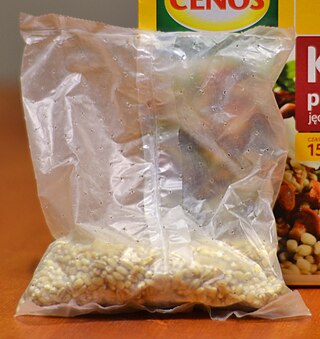
Boil-in-bags are a form of packaged food products in which bagged food is heated or cooked in boiling water. Plastic bags can be solid and impermeable for holding frozen foods; alternatively, bags can be porous or perforated to allow boiling water into the bag.
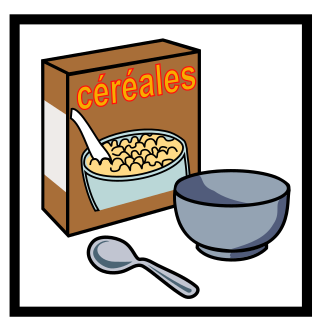
Overpackaging is the use of excess packaging. The Institute of Packaging Professionals defines overpackaging as “a condition where the methods and materials used to package an item exceed the requirements for adequate containment, protection, transport, and sale”


